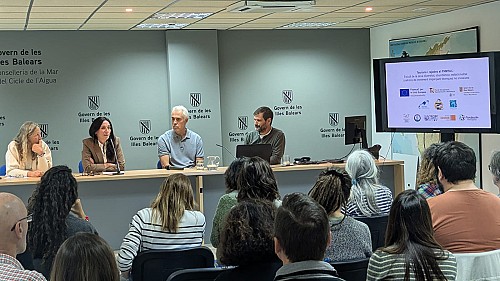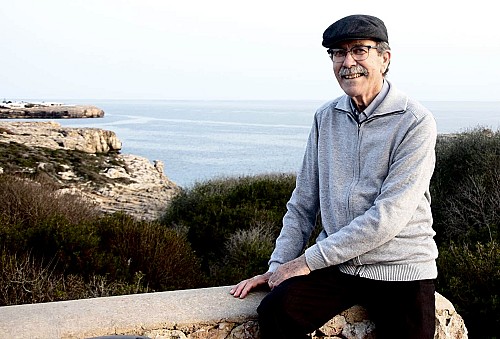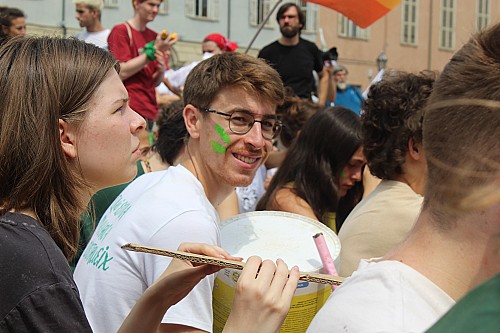“To engage the community, it is essential to be persistent, available, and adaptable”
Published 18.03.2024
Share

Yaiza Santana Bernaldo (Mont-ral, Tarragona, 1989) is a marine biologist with a Master's degree in marine biodiversity and conservation. Her professional career is varied but has a common thread: the link between marine conservation and community.
From a very young age, she was linked to the sea. When she connected with Ecologistas en Acción at university, she began to explore the co-management of fisheries and the intersection between environmentalism and social reality. She worked with marine phanerogams and invertebrate settlement dynamics, participated as a sailor in oceanographic campaigns, and circumnavigated the world for five years in a classic boat following the Magallanes route. This experience gave her a global vision of the reality of the oceans and coastal communities. Yaiza now applies this knowledge on a local scale, coordinating the "Xarxa Dragonera Blava" project at the Save the Med Foundation.
What is the Xarxa Dragonera Blava project?
The projects final objective is to recover the health and biodiversity of the waters of Sa Dragonera, the coastline of Sant Elm and Andratx. To achieve this, we work in three areas: awareness, community, and management of the space. Based on the work we do with the community, the Xarxa Dragonera Blava has created a multi-sector participatory process that aims to achieve participatory governance, that is, the community and the sectors are part of the decision-making process in the management of the coastline of the municipality of Andratx and especially of the waters of Sa Dragonera – Sant Elm. We hold quarterly meetings in a participatory forum and there are currently three working groups in which we work continuously on the priority issues for the community of Sant Elm.
You started in 2019. During these years, what changes have taken place in the involvement of citizens in the protection of marine protected area?
In these four years, we have established a participatory process with representation from all the sectors present in the municipality's coastline: diving, nautical, professional fishing, recreational fishing, local businesses, residents, NGOs/associations, and administration. This is important because the community is learning how to carry out a process with a diverse perspective in which decisions are reached by consensus and listening. This makes it stronger and more resilient.
Could you highlight one or more projects that you have carried out?
Through the participatory process, we have developed a guide to good practices, and we are conducting a communication campaign that we believe will have a very positive impact on people's relationship with the environment. We are also working to make Sant Elm a leading area in terms of boat anchoring management. This line of work is getting a very good response, and we believe that in a short time, we will begin to see results. We have also managed to ensure that local businesses have clear information about the marine environment, about the regulations at Sa Dragonera and that they are involved in taking care of the environment that surrounds them. The administration is also a key player. the General Direction of Fisheries, the management of the Natural Park, and the Town Hall of Andratx are now involved. Everything is going in a very good direction.
What changes have you observed in the Sa Dragonera Marine Reserve?
Since the implementation of the Marine Reserve in the inner waters of Sa Dragonera (2016) and in the outer waters (2020), we have observed an exceptional improvement in both the quantity and size of fish, as well as in the diversity of species. The marine reserve surrounds the island of Sa Dragonera and bathes the coastline of Sant Elm. The area where this improvement is most noticeable is Cap Llebeig. In the last monitoring of the fish of fishing interest, in 2022, it was found that in its inland waters, the size of the fish had increased sevenfold compared to before the creation of the marine reserve and the quantity has increased a lot. For example, the presence of grouper has increased by a factor of 40. This part of the marine reserve can be considered a hotspot of biomass and diversity.
And in the outer waters?
As the outer waters are an integral reserve where no extractive activity is allowed and in some areas, no activity is allowed at all, we are seeing much less impact from hooks or nets. Species that were previously very difficult to see, such as forkbeards (Phycis phycis), grouper (Epinephelinae), and Norway lobster (Nephrops norvegicus), are also starting to reappear.
What are the main pressures on it?
There is a lot of boat traffic passing through the “Es Freu” at very high speeds. This has a direct impact on the marine life in the area, both because of the noise the boats make and the danger of collisions, and on the lives of the residents, as it makes it dangerous to kayak, swim, or be in small boats. Another notable impact is the anchoring of Posidonia by charter boats and the dumping of wastewater from these boats directly into the sea. The management of the town's sewage and, of course, the warming of the water also have an impact.
Do you think the population is aware of the need to protect these areas?
The population is becoming increasingly aware of this need. Especially for two reasons. On the one hand, they notice how the environment is being degraded and the impacts it has. On the other hand, they observe how the marine life in the reserve improves when it is given a little room to recover. There is a lack of clear information about the marine environment and the regulations in the area. We have also noticed that there is a feeling of scepticism that real change can take place. However, through the project, we have also witnessed that this feeling is being transformed into motivation and hope.
What concerns the citizens the most?
Citizens are very concerned about the quality of the waters at Sant Elm, overcrowding, anchoring on Posidonia, boat traffic and speed, and the lack of information and awareness.
Is there a recipe for getting the local community involved? How do you achieve this?
Each community has its characteristics, and the process must be adapted to the place and the local reality. It is essential to listen and not to assume anything without asking. And, above all, being present, complying with what you commit to, making realistic proposals on a scale that can be taken on board, and offering fun and dynamic spaces that make people want to get involved. It is key to be constant, to be available, and to adapt to local needs.
Which sectors are most involved?
During the project, we have seen great involvement of the diving sector, professional fishing, local shops and restaurants, nautical companies, as well as residents and the administration. In the coming years, we want to work more closely with the hotel sector and the recreational fishing sector.
Can you tell us about any experience that you remember especially from these years with the Xarxa Dragonera Blava?
I remember the fifth forum of the Xarxa Dragonera Blava. There we set up the working groups and it was very exciting to see the great participation of local people and to get to work on specific issues that we had decided on through a year-long process of collective enquiry. To see the motivation and the energy, to feel the joy in the air and the certainty that we were on the right track was very exciting and motivating.
Have you always been connected to the sea and when and why did you decide to dedicate yourself to marine conservation?
I have always felt deeply connected to the sea; it makes me feel at home. My father's Canarian origins and the fact that he has lived almost all my life in Mallorca have been a good influence. From a very young age, he brought me closer to the sea, teaching me to read the currents on the beaches, to dive, and to surf. My mother always encouraged my love for the oceans when I told her at the age of 7 that I wanted to be a marine biologist.
QUICK TEST FOR 'SEALOVERS'
A book: El país de las mujeres (The country of women) by Gioconda Belli
An image that evokes the Balearics: A path that runs alongside some orchards and reaches the sea.A marine species: The great barracuda (Sphyraena barracuda)
A person or organisation of reference: Lolita Chávez, a reference in cosmovision, ecofeminism, and community work and the link between the community and nature
A beach: Cala Mesquida in winter (Mallorca).
Optimist, realist, or pessimist? Optimist.




